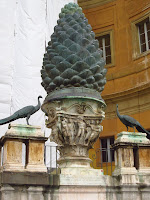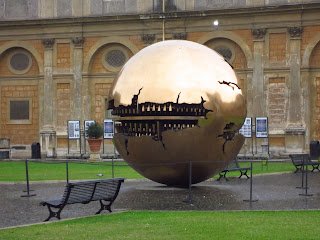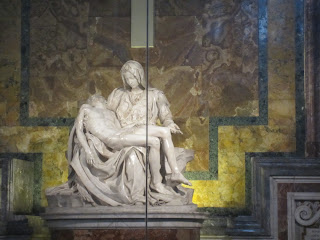Our focus moved forward to the Renaissance era and it was another full day of marveling at collections of riches: marble statues, mosaic floors, golden ceilings, tapestries, frescoes, and gigantic buildings. The main players for today were Michelangelo, Raphael, Bernini and the popes who hired them. The all day rain didn’t affect our sight seeing much since we were inside the Vatican. Again, we felt very fortunate to be part of a tour that could go right into the museum instead of waiting outside to buy tickets.
A rainy day at the Vatican
Before we toured the Vatican Museum, we went to the Belvedere Courtyard where charts explained the Sistine Chapel frescoes. We were not able to take photos inside the Sistine Chapel so some prior hints about what we would see were helpful. There were other sculptures of interest as well.
 |
| Pine Cone--symbol of Eternal Life |
 |
| Sistine Chapel Guide |
 |
| Sphere Within a Sphere, symbolizes the harsh difficulties of the modern world |
Once inside the Vatican Museum, we concentrated on the highlights of the collection—even then the amount of information was overwhelming.
Of all the small Roman statues, I found this set most charming. I thought it could be used as an advertisement for a Roman beauty salon.
Four statues stood out among many for either their past significance or influence on Renaissance (Michelangelo) sculptors.
The Apollo Belvedere, a copy of a Greek statue, was once thought to be the most perfect work of art. He’s beautiful as both an athlete and a thinker; he shows movement but he’s not out of control, and he’s realistic but with godlike features. Everything is in perfect balance. However, today, he looks unemotional.
The pose of this statue of a Roman river god served as a model fro Michelangelo’s Adam in the Sistine Chapel.
Unlike the Apollo statue, this one of Laocoon and his sons being crushed by snakes is full of emotion and movement. Laocoon has just warned the Trojans to “beware of Greeks bearing gifts” (the Trojan horse) but the Trojans think he is being punished by the gods and ignore him.
The Museum’s collection continued with dazzling ceilings, purple marble from Egypt, a bronze statue, and tapestries.
Porphyry marble from Egypt. It is rare but there seemed to be quite a bit of it in the Vatican Museum.
The only bronze statue in the museum
Tapestry, made in Brussels from drawings by
Raphael
The last part of the Museum that we studied was the Raphael Rooms and in particular, his frescoes of “The Dispute” and “The School of Athens.” A favorite of Pope Julius II like his contemporary Michelangelo, Raphael possessed a much different temperament—sophisticated, handsome, more easy going and perhaps more generous. After seeing Michelangelo’s work in the Sistine Chapel, Raphael paid homage to him by adding the brooding figure of Michelangelo resting on the block of marble in the “School of Athens” fresco.
"The Dispute" Christ and the saints oversee a discussion of the Eucharist by mortals
"School of Athens" Raphael pays homage to the great thinkers of ancient Greece and the Renaissance.
Finally, the Sistine Chapel. Michelangelo created the nine panels on the ceiling in the Sistine Chapel along with “The Last Judgment,” the painting on the altar wall. The panels are scenes from Genesis with the fourth one being the creation of Adam. It is a true Renaissance perspective since God and Adam are on the same plane. By the time Michelangelo painted the altar wall 23 years later, the spirit of the Renaissance had dissolved into a more somber mood. The Protestant Reformation and the Catholic response turned the figure of Christ in “The Last Judgment” into a terrifying figure condemning the unjust to a life of torture while raising up the just.
We were told that there were far fewer visitors than normal to the Sistine Chapel but it still felt like a huge throng. The guards’ modest attempts to keep the crowd silent were futile.
The Basilica was the last part of our Vatican visit on Tuesday. Due to chairs set up in the Basilica, we were unable to get close to some statues like the one of St. Peter. We saw the tombs of Popes John XXIII and John Paul II; I’m hoping it was a mask I saw of John XXIII but his face (large nose) was easily recognizable.
Front of St. Peter's Basilica. The balcony is where the new pope is introduced.
Cross topped obelisk in St. Peter's Square.
Statue of St. Peter--perhaps once the statue of a Roman senator with a different head
 |
| The Pieta now behind bullet proof glass |
Bernini's Canopy over the Altar
Once we left the Vatican, we walked towards Castel Sant’Angelo, tomb of several emperors including Hadrian and home to popes under siege. The bridge spanning the Tiber, Ponte Sant’Angelo, has sculptures of angels each bearing a symbol of Christ’s passion.
Rome is more than ruins, marble, and monuments. It is also music and we were able to attend a concert of opera arias in a nearby church. The evening was a delight and now on my bucket list is a desire to see an opera performed in a beautiful outdoor (preferably ancient) setting (the Cincinnati zoo does not qualify).
St. Paul's Anglican Church, site of a lovely concert























No comments:
Post a Comment